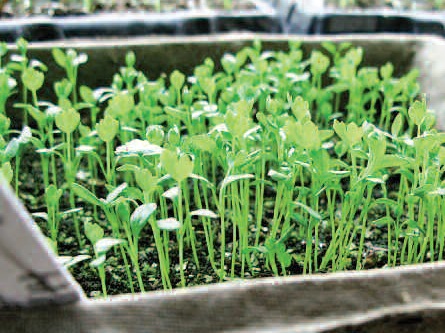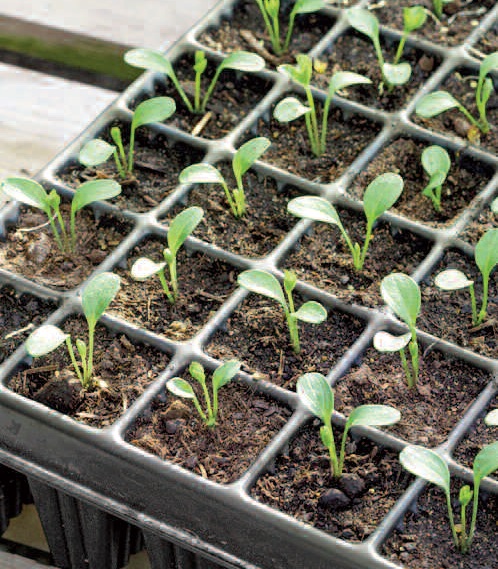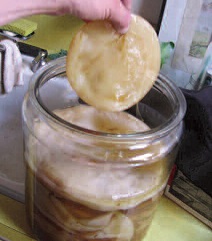GARDEN WORKS: Antidotes for spring fever
 GARDEN WORKS
GARDEN WORKS
by Emily Cates
Coping with the mad rush of springtime
Bam! What happened? Spring has thundered through with a crash and a bang! In just a few days, my yard has changed from snow, to mud, and to plant-able ground in some spots. The quiet woods have burst forth with songs of birds and woodland creatures during the day, while the spring peepers serenade me to sleep at night. Canada geese make their return with buoyant honking overhead, their whispering wings moving them through the air as they search for open water. Various insects take off into the moist air laden with the scent of mud, yawning for just a moment before they boldly buzz around. All of this the atmosphere of a season that has sprung, and a stark reminder that one of the most intense times of the year has begun.
A late start to what we have become accustomed to, this springtime beckons in a narrow window of opportunity where tasks must be completed. “Do or die, now or never, get it done!” I’m thinking as I run in circles trying with all my might to tackle the to-do list while there’s still time. Those around me are undoubtedly annoyed with my persistence when I tidy-up the permaculture beds, frantically digging up suckers and daughter plants, looking for good homes for them before they break dormancy. “Oh no, not another plant!” my friends and neighbors exclaim after finding another ‘orphan’ on their doorstep. “All those perfectly good prunings! What a shame to throw them away,” my conscience nags as the clippers do their deed. Of course, the seed swap and scionwood exchange at MOFGA is weeks past, making it an even bigger challenge to figure out what to do with everything. To top it all off, the FEDCO tree sale is April 28 and 29 for customers with pre-orders, and then the next weekend May 5 and 6 for the general public – so I have to make room in the garden for more plants! Some folks would feed their surplus plants and cuttings to their goats in the spirit of waste not, want not. If only it was so easy….
This probably sounds silly, but it’s taken me a couple of days to write this, as I can only get to a sentence or two before I get restless, run outside, and attack another task on the list! If your sentiments are similar to mine this time of year, then we’re in need of some serious focus so as to make the most of limited time. With all this in mind, here are a few strategies that might help take the edges off spring madness without cutting corners. Let’s look at a few time-sensitive tasks such as pruning and planting, along with a healthy dose of prioritizing and planning.
First, it helps to assess the situation. Is the whole garden thawed, or just parts? Unless we have perfectly drained raised beds with soil that has the texture of a wrung-out sponge, then rototilling is out of the question for now. (However, judiciously tilling by hand can be easier on the soil structure and may possibly be done a bit earlier than using a machine.) Got coldframes, tunnels, or row covers? You might have a jump on the season. Still frosty? Forget planting anything tender. Peas are probably an option, along with other cold-tolerant plants such as cole crops, leeks, onions, potatoes, carrots, and radishes.
Also, it should still be okay to prune or plant pruning fruit trees, vines, and shrubs if they’re still on the dormant side. Grapes will probably bleed if you prune them once it warms up – but they should be all right. These plants can be dug up and moved right now if needed. Don’t be afraid to plant them if there’s still snow on the ground; as long as you can dig a hole, you can plant a tree. (I’ve even dug through a layer of frost in the ground to plant trees, and they were fine – despite the inconvenience.) Remember to water the newly-planted!
In addition, don’t forget to remove tree guards and check for winter damage from snow and munching critters. While we’re at it, let’s ensure everything is labeled properly.
Fencing and trellises – which should be a priority – are easier to install before the ground swarms with vegetation and hungry creatures looking to make a meal out of whatever we plant.
If, like me, you did not get a chance to mulch your garlic last fall, then by all means, be sure to do this right away before it sprouts. That way, the garlic shoots will be able to grow up through the mulch, rather than be broken off when the mulch is applied. Speaking of mulch, it may be a good idea to apply it wherever it is welcome before weeds get a foothold.
And, speaking of applying things, folks who keep farm animals find that this time of year is preferred to clean out pens and spread the manure on the garden. A moderate breeze keeps the black flies away, but take care to use the wind to your advantage!
All right, I better quit typing and get back to work! Hope you enjoy this beautiful, productive time of year and all the wonders Springtime has to offer.



 Now let’s look at is what to plant. Long-season seedlings that take a long time to get to a plant-able size from seed are happiest and most productive when started early. If these seeds were sown directly in our gardens here in Central Maine, they likely would not have time to reach their full potential. That’s why we start them early indoors. The cast of characters starring in your grow system could include leeks, onions, peppers, tomatoes, eggplant, artichoke, long-season herbs, and perennial flowers. Most likely it will state in the seed catalog or on the seed packet whether or not the seed needs to be started early. Since here in Maine we can get anywhere from 90 to 140 frost-free days, it is important to pay attention to the days needed until harvest that is listed with the seed. Timing is everything, which goes along with our next point:
Now let’s look at is what to plant. Long-season seedlings that take a long time to get to a plant-able size from seed are happiest and most productive when started early. If these seeds were sown directly in our gardens here in Central Maine, they likely would not have time to reach their full potential. That’s why we start them early indoors. The cast of characters starring in your grow system could include leeks, onions, peppers, tomatoes, eggplant, artichoke, long-season herbs, and perennial flowers. Most likely it will state in the seed catalog or on the seed packet whether or not the seed needs to be started early. Since here in Maine we can get anywhere from 90 to 140 frost-free days, it is important to pay attention to the days needed until harvest that is listed with the seed. Timing is everything, which goes along with our next point: A second ingredient to successful seedlings is the substrate. Always remember to use organically-produced, fresh, pest and disease-free planting medium, whether purchased or homemade. Products that support germination are fine-textured and oftentimes do not contain soil. (These are especially helpful for starting small seeds.) Examples are peat, coir, vermiculite, etc. When purchasing bags of medium, look for those specifically formulated for germination. (Later on, when transplanting, we’ll use a coarser mix with organic matter to provide nutrition for the growing plants- but for now we’re just interested in germination.)
A second ingredient to successful seedlings is the substrate. Always remember to use organically-produced, fresh, pest and disease-free planting medium, whether purchased or homemade. Products that support germination are fine-textured and oftentimes do not contain soil. (These are especially helpful for starting small seeds.) Examples are peat, coir, vermiculite, etc. When purchasing bags of medium, look for those specifically formulated for germination. (Later on, when transplanting, we’ll use a coarser mix with organic matter to provide nutrition for the growing plants- but for now we’re just interested in germination.)